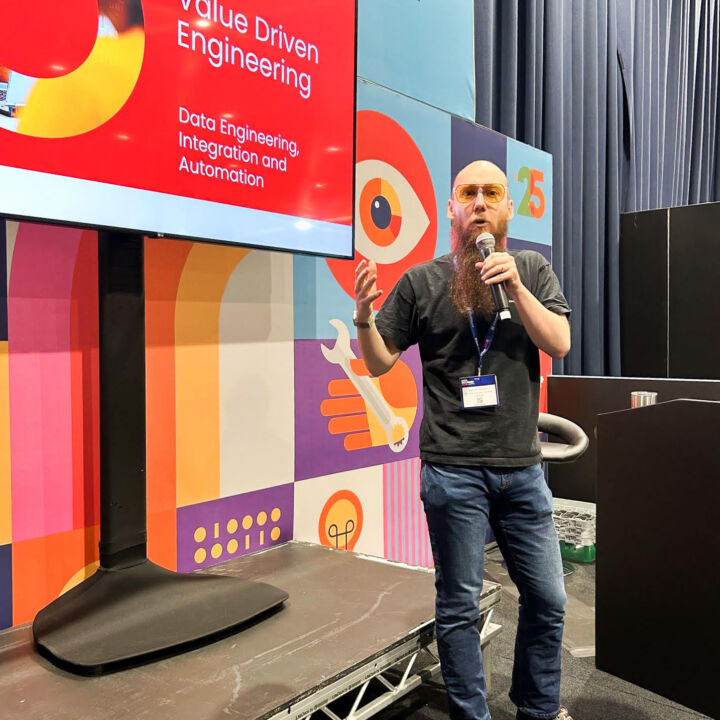Data Decoded: How to go from “we want to be data-driven” to “we are data-driven”.
We hate to break it to you, but there isn’t any natural ROI in building a data platform. The ROI happens when decisions get made from that platform. As a data engineer or data platform consultant, you build around four key functions: Ingesting, storing, transforming, and serving the data. If your platform does these four things, you’re in business. But just because you can tick all four pillars of a data platform doesn’t mean you can tick one that says it provides ROI, too.
Here’s why.
The Four Pillars of a Data Platform Build
We’ll start with the four functions in more detail:
- Ingest – bringing data in from source systems (ERP, CRM, cloud apps, IoT, etc).
- Store – persisting the data in a suitable repository (data lake, warehouse, lakehouse).
- Transform – modeling, cleansing, structuring, and preparing the data for use.
- Serve – providing access: dashboards, BI tools, ML models, APIs.
Many data engineering projects start with the diagram ingest → store → transform → serve. And that’s fine. But companies fall into the trap of believing: “we have dashboards, we have a lakehouse, we have streaming ingestion”, therefore “we’re data-driven.” But that’s wrong. If you haven’t tied it to decision boundaries and measurable outcomes, you are spinning wheels.
A Platform Doesn’t Equal Value
Data platforms have cost: Infrastructure, licences, engineers, maintenance. Without real usage and decision-making, you could have a negative ROI. For example, a data platform sitting idle still costs you £5-10k/month in cloud costs.
Jump into this further by reading: How to Manage Spiralling Cloud Costs.
What Does A Data Consulting Company Do?
A good data consultant doesn’t just build a stack. They ask:
- What decisions will this support?
- What value will it deliver?
- How will we know?
A data consultant helps you avoid the “acquisitive” trap and guide you to become value-driven.
Here’s what our data consultants often advise:
Define business outcomes first
Understand what business decisions you want from the data (pricing decisions, logistics optimisation, customer segmentation, risk reduction).
Set decision boundaries
For each key metric, define the threshold to drive action.
Align data product scope to value
Don’t build everything. Prioritise data products (dashboards, ML models, APIs) that map to time/money/opportunity.
Ensure adoption & governance
A platform is only useful if business users engage with it.
Track ROI continuously
Measure before-and-after, quantify value, build case studies. For example, when consultants deliver dashboards & platforms they embed tracking: “We reduced reporting cycle time by X hours, we reduced cost of chasing data by Y, we improved conversion by Z%.”
Good consulting keeps the focus on action, not just architecture. Learn more: What is Data Platform Architecture?
How Do You Get Value from a Data Platform?
Let’s break down meeting the four pillars of a data platform into actionable steps:
Step 1: Start with Decisions
You must map which decisions your organisation needs to make routinely. For example:
In utilities: “If usage anomaly > 5%, then investigate the customer meter.”
In transportation: “If fleet-cost per km > X, then re-route fleet or renegotiate contract.”
In tech: “If process latency > X, trigger optimisation run.”
From there, you define the data that will inform that decision.
Step 2: Build Decision Boundaries
As noted earlier, define thresholds in advance. Know what numbers trigger what actions. This ensures your dashboards don’t just show “what happened”, they support “what we will do”.
Step 3: Build the Platform Lean
Instead of “ingest everything”, you prioritise the data sources that serve those decisions. Map ingestion, storage, transform, and serve accordingly. Then build the initial version – it may just be a reporting store – then grow from there: more domains, real-time streaming, ML models.
Step 4: Operationalise the Platform
You need adoption. Business users must use the dashboards, models must deliver insights, the thresholds must be monitored and acted upon. If your data platform is just “nice to have”, it won’t deliver ROI. Remember: value comes when decisions change behaviour.
Step 5: Measure Value
You must link back to time, money or opportunity. Use frameworks to estimate value – for example:
Data ROI = (value from data initiative – cost of initiative) / cost of initiative
Track metrics such as: time saved, cost avoided, revenue gained, risk reduced. Get evidence around before / after.
Step 6: Iterate and Expand
Your first data product may be reporting. You then add real-time streaming, machine learning, and automated decisioning. The “lighthouse model” (start small, show value, expand) works better than big-bang POCs that die.
Two down, one to go! For more insight like this, please read the third and final blog in this data decoded series: Common Data Pitfalls & How to Avoid Them. You can also send your questions to me or speak with the rest of the Oakland consulting team by getting in touch – we’d love to hear from you.


